Over the Years
Home > Over the Years > > HICARE mission to Mongolia
HICARE mission to Mongolia
The purposes of the mission are:
To study radiation-exposure treatment / treatment systems in Mongolia.To discuss how HICARE can support patients
Period:
Members:
| Masaharu HOSHI | Professor, Hiroshima University Research Institute for Radiation Biology and |
|---|---|
| Masashi MATSUO | Professor, Hiroshima University Institute for Peace Science |
Organizations visited (in order of visit):
Ministry of Health
Shastin Central Hospital
Mongolian National University
Others
Impressions
In 2006, Dr. Naymsuren Tuvshinbat, President of the IPPNW Mongolian Branch, was invited to Hiroshima as a HICARE trainee. He visited Hiroshima University, explaining that there may be two areas suffering from radiation exposure: the western area covered by clouds containing radiation from Semipalatinsk / Lop Nur; another is a uranium mine located in the east. He explained that no investigations had been carried out by Mongolian organizations. I suggested an environmental survey via questionnaire as well as a soil assessment via cesium 137 measurement. Approximately 20 persons subsequently conducted a preparatory survey after Dr. Tuvshinbat returned to Mongolia: he announced the results at a Symposium held in RIRBM, managed by Professor Masashi MATSUO.
The purpose the current visit was to visit hospitals, universities, and institutes, observing the facilities as well as confirming the findings of past research. Professor MATSUO accompanied us. We were warmly welcomed at all of the locations we visited. Dr. Tuvshinbat accompanied us during our stay. Mr. Margad, tourist guide, also saw to our various needs.
March 19, 2007
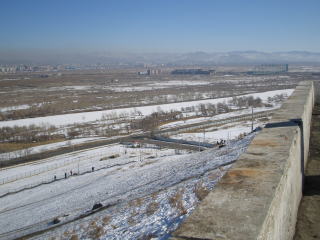
on "Zaisan"hill overlooking Ulaanbaatar
March 20, 2007
We visited Professor Sodnomdarjaa. R, General Director at the State Central Veterinary Sanitary and Diagnostic Laboratory. There we observed the equipment utilized during the cesium 137 measurement procedures, recently provided by the IAEA. Given the utilization of nearly $128,000 dollar equipment, the laboratory had just began its operations. He agreed to our proposal to conduct further surveys together.
Next, we visited Dr. Enkhbat Sodnom, Secretary of the Mongolian Nuclear Energy Commission, a Mongolian nuclear institute. The institution itself did not have measurement facilities. We decided to visit the laboratory which establishes cesium standards the following day.
Next, we visited Professor Ts. Adyasuren, Head of the Mongolian Ozone Union and former Ministry of the Environment. The Union is similar to an “Environmental” University. He explained the environment monitoring systems.
Lastly, we visited Professor Batsereedene Byambaa, State Secretary at the Ministry of Health. We also met the female secretariat of the Ministry of Health, Dr. Tuvshinbat's pupil. The Ministry also agreed to our survey.
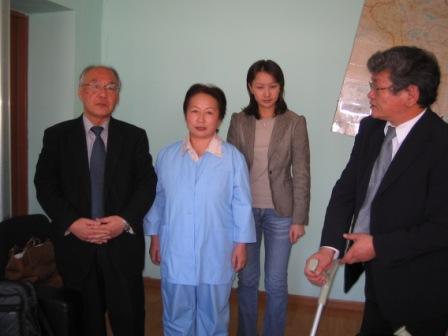
Prof.Sodnomdarjaa (General director,State Central Veterinarysanitary and Diagnostic laboratory)and persons concerned
March 21, 2007
We visited the Shastin Central Clinical Hospital where Dr. Tuvshinbat is working. At the hospital, equipped with 400 beds, medical personnel including a number of young doctors are working actively.
At the Mongolian Nuclear Energy Commission, we observed the cesium standard adjustment / measuring equipment. The equipment was located in the basement of the building, however it seemed quite old and failed to work properly.
At noon, we had lunch with Dr. Enkhsaikhan Jargalsaikhan, Ambassador as well as General Director of Blue banner Co., Ltd, exchanging opinions. We heard that he had a map showing the radiation contamination in Mongolia’s western region. Though the map he brought us the next day showed contamination areas in the Eurasian continent, we did not think it a specialized map.
Hearing that the Nuclear Research Center, National University of Mongolia had a germanium counter, we altered our schedule, attempting to visit Dr. N. Norov at the center. Unfortunately, we were unable to meet him due to a business trip. There we found an old counter produced by the Canberra Co., in addition to other analysis equipment (X-ray / X-ray analysis equipment). Though they had conducted soil measurement activities they had not yet produced a contamination map. We promised to together conduct survey activities.
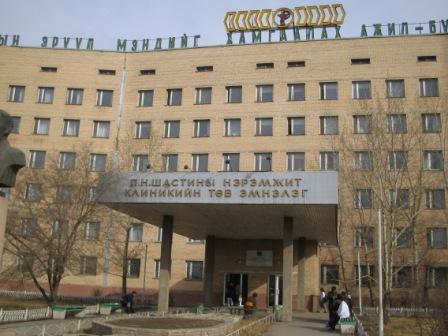
the Shastin Central Clinical Hospital where Dr.Tuvshinbat is working
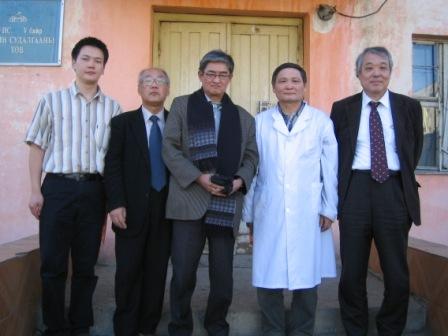
the Nuclear Research Center,National University of Mongolia Dr. N. Norov
March 22, 2007
Together with our translator we toured the city. Given that the country is predominantly Tibetan Buddhist,we also had a chance to visit a rather large temple.Other experiences included a visit to a natural history museum as well as the chance to purchase souveniers at nearby department stores.
In the evening we had a few drinks at a tent-shaped hotel nearby the airport. Professor Tuvshinbat,his son,and all the trip staff took part.Leaving for the airport at about 10pm,We departed for Seoul at around midnight. We evevtually arrived at Hiroshima via Fukuoka the next morning.
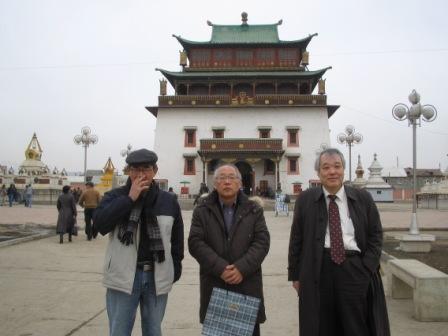
At a temple of Tibetan Buddhism
Conclusion:
Throughout the visit we felt a strong familiarity with the people of Mongolia. In the downtown area, Japanese sumo is on TV; in offices people watch sumo programs broadcast by Mongolian TV companies during working hours. Sumo is very popular with nearly every generation including the young.
We felt that activities in cooperation with Mongolian scientists could proceed quite sucessfully. We would like to visit again! Next time we hope to be able to conduct actual studies with Mongolian medical personnel.
Masaharu HOSHI




